Introduction to Barn Quilts
What is a Barn Quilt?
Understand that barn quilts are large pieces of wood painted to resemble quilt blocks. They have a long history of being hung outside homes and barns in the US to bring good luck and prosperity. Originating hundreds of years ago, barn quilts were originally intended as a simple decoration on utilitarian buildings (barns) that weren’t typically painted. They came to the United States with the colonists and have continued as part of the tradition of the Pennsylvania Dutch. For those early settlers, barn quilts were a way of holding on to their heritage. They fell largely by the wayside until 2001 when the resurgence began.
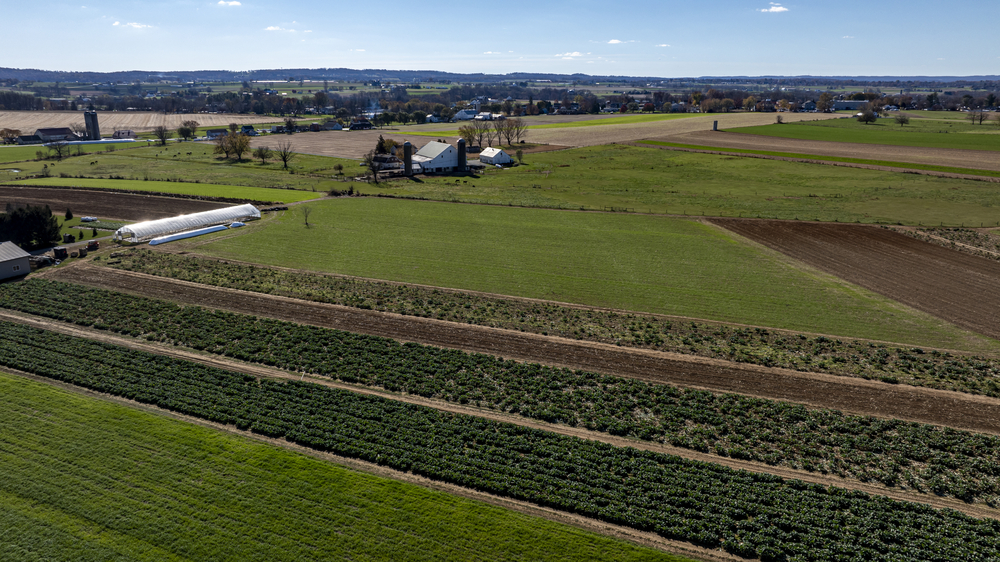
Donna Sue Groves started the modern version of the barn quilt to honor her mother and her Appalachian heritage. The first modern barn quilt was hung on Donna’s barn in Adams County, Ohio.
Barn quilts are now appearing in over 40 states and across Canada. They are popular enough that people create “trails” mapped out showing where barn quilts are located and can be viewed. The old custom of a Sunday afternoon drive can be made more enjoyable by following one of these trails and seeing what others have crafted.
Barn quilts in actual barns need to be quite large. Typically, they are painted on two standard sheets of plywood, creating an eight-foot square. But many people make smaller barn quilts for decorating inside and outside their homes. These smaller quilts are usually two feet square.
A typical barn quilt doesn’t show a whole quilt but rather merely one square of a quilt. Depending on the quilt design and maker, the squares on the quilts that these designs are taken from can range from about four to 12 inches square. Regardless of their size, however, one of the basic concepts of quilting is that all quilts are made with geometric precision, which is part of their inherent beauty.
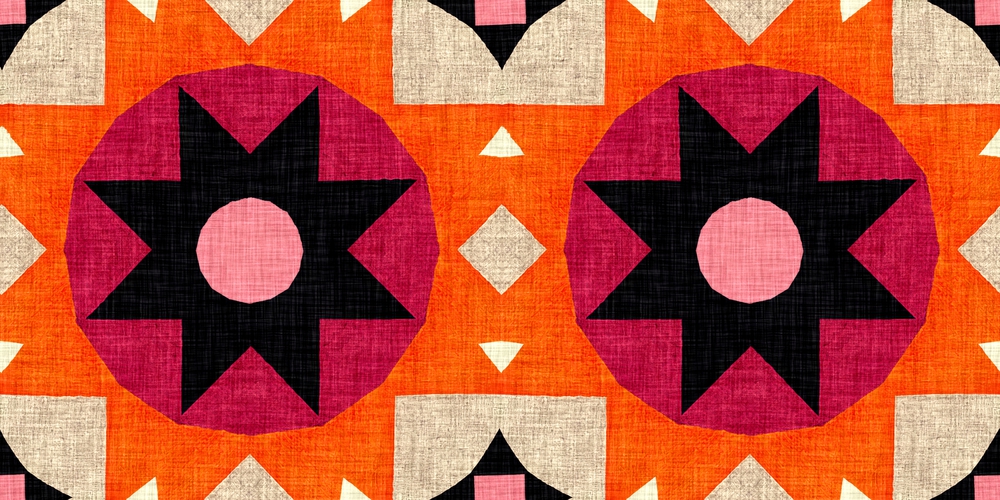
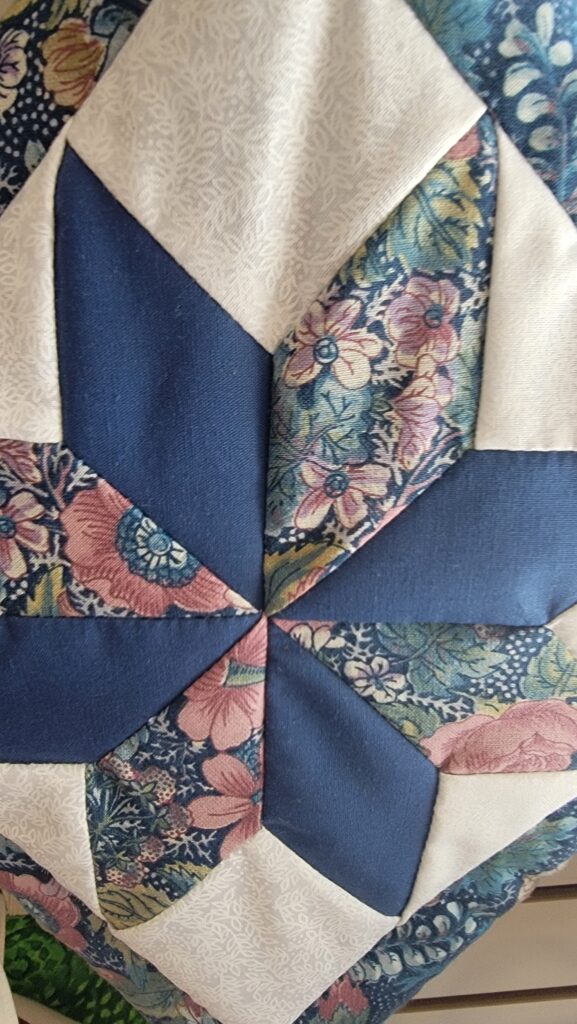
Making a Barn Quilt
The physical construction of a barn quilt is simplicity itself. It is nothing more than a plywood square. Even so, it’s a good idea to make a frame for that square to maintain its structural integrity and flatness. Unsupported plywood can bow and twist somewhat, and plywood fresh from the lumberyard will often be cupped somewhat, a leftover from the way it is manufactured, stacked, and shipped.
Just about any plywood can be used to make a barn quilt, but you will get the best results from working with smooth-surfaced plywood, like a signboard. If you can’t get a signboard, a sanded softwood plywood or MDF (medium-density fiberboard) will work almost as well. Paint it with a couple of coats of sealer before painting the design to keep the paint from soaking in. One-half-inch thick material is usually considered to be ideal. You don’t want to go thicker than that, especially with the larger barn quilts, as they can become extremely heavy.
The simple craft of making barn quilts has had a resurgence since the turn of the century after a long hiatus. Originating hundreds of years ago, barn quilts were initially intended as a simple decoration on utilitarian buildings (barns) that weren’t typically painted. They came to the United States with the colonists and have continued as part of the tradition of the Pennsylvania Dutch. For those early settlers, barn quilts were a way of holding on to their heritage. They fell mainly by the wayside until 2001, when the resurgence began.
Process How To Make Barn Quilts:
- Design Selection: Choose a quilt pattern and scale it to fit your desired size.
- Materials: Gather exterior-grade plywood, primer, paint (exterior acrylic or latex), painter’s tape, brushes, and a measuring tape.
- Prepare Plywood: Cut plywood to size and sand smooth. Apply primer and let dry.
- Draw Grid: Create a grid on the primed plywood using a pencil and ruler to guide the pattern.
- Tape-Off Sections: Use painter’s tape to mask off areas where different colors will go, following your quilt pattern.
- Paint Layers: Apply paint in layers, first with the lightest colors. Let each layer dry completely before removing the tape or applying the next color.
- Remove Tape and Finish: Carefully remove the painter’s tape once all paint layers are dry. Touch up any edges if needed. Optionally, apply a clear coat for extra protection.
- Mounting: Mount the finished barn quilt securely on your barn or desired location using exterior screws or a mounting bracket.
- Enjoy: Step back and admire your handiwork! Your barn quilt is now ready to be enjoyed as a unique piece of outdoor art.
By following these steps, you can create a beautiful barn quilt to add a touch of color and charm to your property. Now, here are more details about making a Barn Quilt.
Making a Barn Quilt
The physical construction of a barn quilt is simplicity itself. It is nothing more than a plywood square. Even so, it’s a good idea to make a frame for that square to maintain its structural integrity and flatness. Unsupported plywood can bow and twist somewhat, and plywood fresh from the lumberyard will often be cupped somewhat, a leftover from the way it is manufactured, stacked, and shipped.
Just about any plywood can be used to make a barn quilt, but you will get the best results from working with smooth-surfaced plywood, like a signboard. If you can’t get a signboard, a sanded softwood plywood or MDF (medium-density fiberboard) will work almost as well. Paint it with a couple of coats of sealer before painting the design to keep the paint from soaking in. One-half-inch thick material is usually considered to be ideal. You don’t want to go thicker than that, especially with the larger barn quilts, as they can become extremely heavy.
Large Barn Quilts
You’ll need two full sheets of plywood to make a traditional, full-sized barn quilt. These will need to be connected by the frame, usually made out of 2”x 4” dimensional lumber. As you can see in the drawing below, the frame overlaps the joint, holding the two halves together.
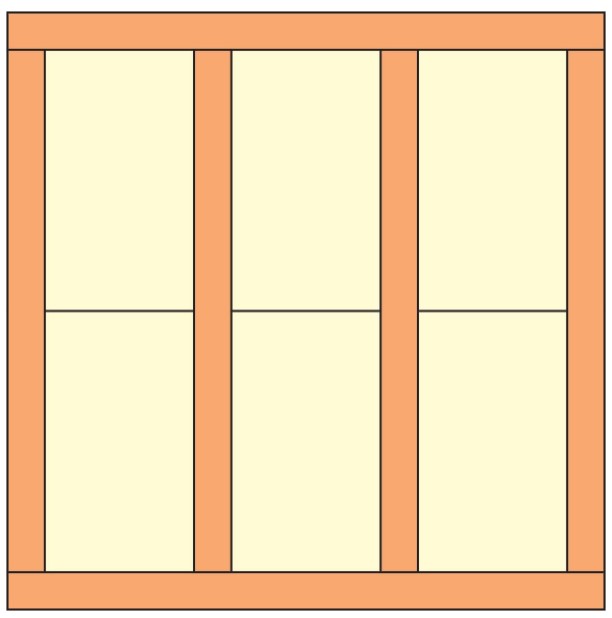
When connecting the two halves, it is a good idea to caulk the seam between them so that no water can enter into this seam. Don’t caulk it from the outside, but run a bead of caulk down the edge of the plywood, between the pieces, as you put them together. Wipe off any excess caulking that squeezes out of the seam. Attach the plywood to the frame with 1-5/8” drywall screws, being sure to drill and countersink the holes in the plywood so that the screw heads will be below flush. Fill the holes with wood putty, sand smooth, and flush with the surface once the putty dries.
It is also good to caulk the seams between the 2”x 4”s and the plywood and the seams between the 2”x 4”s so that water cannot get between them. You want your barn square to last; water is the biggest enemy against this. In addition, coating the end grain on the 2”x 4”s and the plywood edges with caulking will help seal them against the weather, adding life to your square. Smooth this caulking in with your finger so that it isn’t lumpy. Caulking will provide a better weather seal than any paint because it is thicker, especially when protecting the end-grain of boards.
Note how the top member of the frame, in the drawing above, runs the full width of the square. This is intentional so that the end grain does not face directly up. Water soaks into the end grain considerably easier, so by capping the end grain, we reduce the chance of water soaking in.
Small Barn Quilts
If you are making smaller barn quilts for decorations inside or outside your home, you probably won’t need to connect the pieces of plywood. You may still want a frame to add stability and rigidity to the barn quilt. These frames can be made out of 1”x 2”s, 1”x 3”s, or 1”x 4”s.
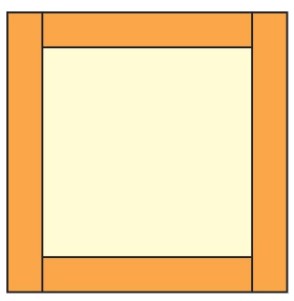
This frame is also attached to the back of the barn quilt, leaving the finished piece unframed and maintaining the original style. As with the larger barn quilts, you’ll want to caulk the joints between the boards and the plywood, the edges of the plywood, and the end grain on the frame to keep water out if you plan on using the barn quilt outdoors.
How to Paint Barn Quilts
There are two principal concerns in painting barn quilts. The first is that the paint lasts. It is difficult enough to paint a barn quilt, so you don’t want to repaint it after two or three years. So you’ll want to use several coats of paint on the entire board, both sides, to ensure that it doesn’t get damaged by water. Please note that it is essential to paint the backside so that the drying paint doesn’t strain the plywood, causing it to warp.
Before painting the barn quilt, I recommend sealing the edges of the plywood. Like all engineered wood products, plywood soaks moisture faster through the end grain than anywhere else. Sealing the edges will protect it from the rain more than anything else. To do this, use typical latex painters caulk on your finger, as I mentioned above. Put a small glob on your finger and wipe it onto the edge, pressing the caulking into the grain.
Prime the back of the project with three coats of primer and two coats on the front side before applying the color. Unless you suspend the barn quilt on a string, you’ll have to paint one side at a time. Flip the quilt between coats, alternating sides to prevent it from warping.
Painting the Design
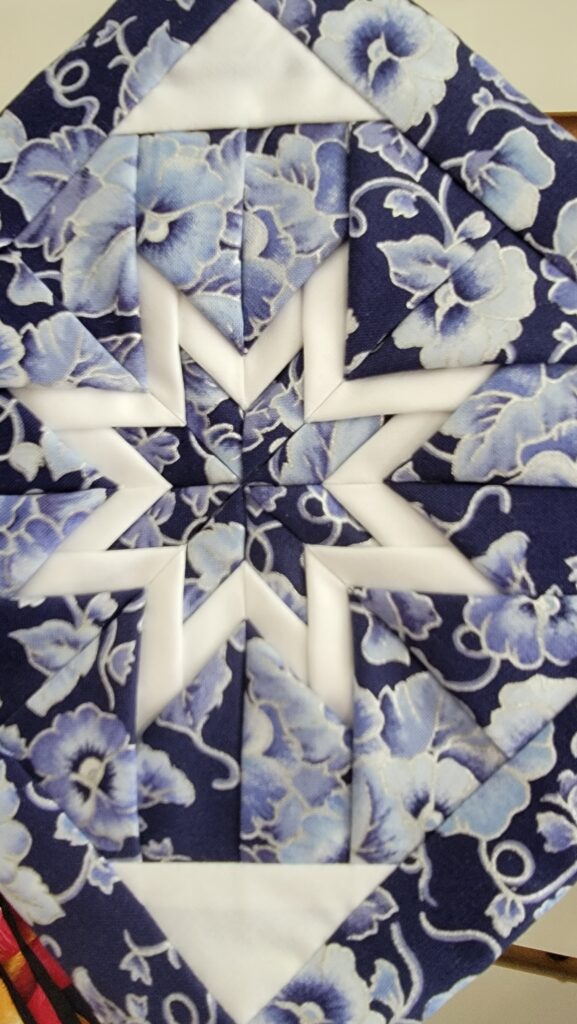
Now, we get to the fun part: painting the design of your barn quilt. Start by painting the entire front and edges with two coats of the lightest color you will use for your quilt. Allow these to dry thoroughly. Since barn quilts are geometric designs, we must lay that design out on the painted plywood, using a tape measure, a straight edge, and quite likely a protractor. Remember that you can do a lot by marking off the midpoints of each side or dividing the sides into four equal sections. A chalk line is not recommended, as that could discolor your paint. Lay the entire design in pencil, ensuring it is dark enough to see.
You will want to use high-quality masking tapes, such as Frog Tape or ScotchBlue, to mask the edges of your areas to paint, pressing the edges down so they will seal well. Work on only one color at a time, masking and painting all the places to be in that color with high-quality latex paint. You will need at least two coats of paint to cover thoroughly, allowing the paint to dry between coats and before removing the tape.
High-gloss paints are not customarily used for barn quilts, as they reflect more sunlight than a duller sheen will. Flat paint, at the other extreme of the glossiness scale, will hold more dirt, dulling the paint. You’re best off using eggshell or satin paint, which provides a smooth enough surface to stay clean without reflecting too much sunlight.
Barn Quilt Patterns
You can use any square quilt pattern to make a barn quilt. Don’t select pastel colors or colors that are close to each other. They may look fantastic close-ups, but at a distance, they blend. Instead, you want colors with a lot of contrast to make your pattern stand out.
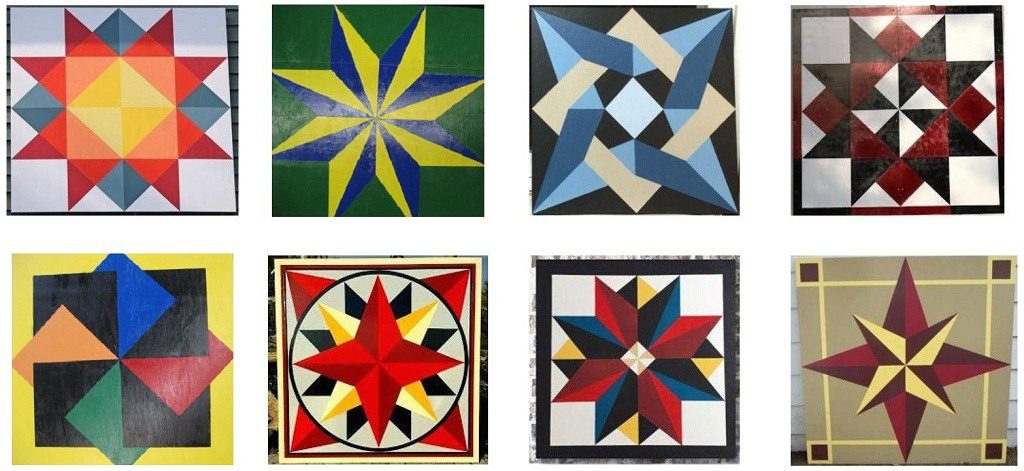
These are just a few examples of the patterns you can use for your barn quilt. A quick search online will show you countless more that you can choose from. Any quilt pattern can be used to make a barn quilt.
Part of the fun of making a barn quilt is figuring out how to lay out the design geometrically. Some of these designs can be pretty challenging to do. Don’t lose your patience. There’s always a way to lay it out using the simple tools I mentioned earlier. Usually, the designs are laid out in quarters, eights, and sixteenths of a circle. So, drawing lines radiating from the center at every 20, 30, or 45 degrees will give you a good starting point.
Count the number of points in the design to know how many degrees to put between those lines. For example, the design in the lower left above only has eight points, whereas the one in the top row, the second from the left, has 12 points. Based on this, spread your lines out by:
| Number of Points | Degrees Between Lines |
|---|---|
| 4 | 90 |
| 8 | 45 |
| 12 | 30 |
| 16 | 22.5 |
| 18 | 20 |
Don’t be fooled by design with double points parallel to each other, like the design in the upper right corner. While the design has 12 points, they are grouped into four sets of three points. Only the red points determine direction, with pairs of blue points bracketing each red one. It is easy to tell this because no blue points are pointed directly out from the center.
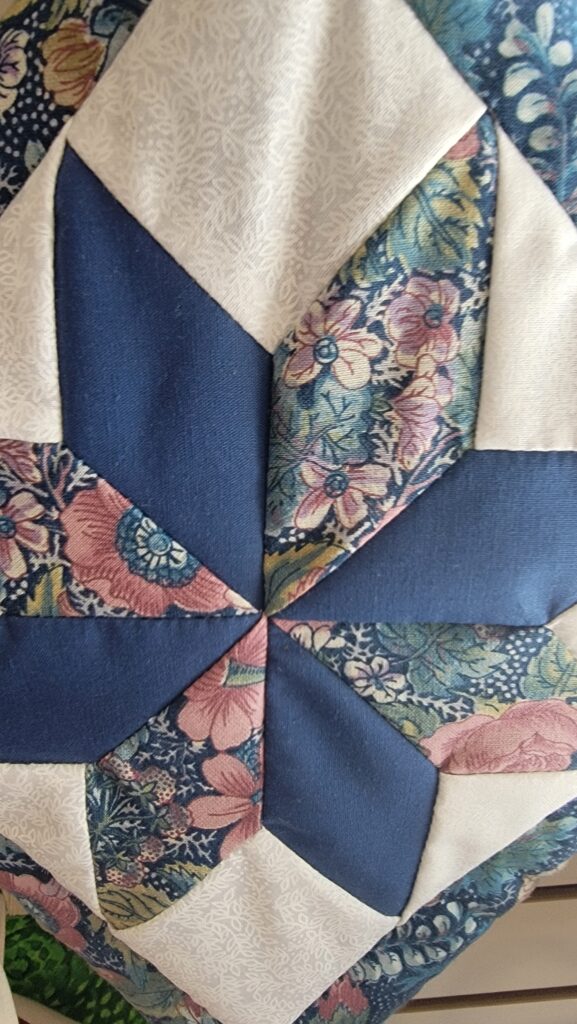
Another helpful tool for laying out your design is a string compass. This is a string with a pencil tied at one end and a nail at the other. The nail is lightly tapped into the center, and the pencil is then used to draw a circle around that center. The length of the string can be adjusted to change the size of the circle.
Circles are helpful not only where they are apparent in the design, such as the second one from the left in the bottom row, but also to define spacing from the center of the circle. You can measure from the center for each point in the second design from the left in the top row, or you can use a string compass to determine where the points should be, creating an intersection between the radial lines and the circle. Of the two methods, making the circle is faster and easier.
You may want to experiment with drawing the quilting square designs on paper before doing them on an actual quilt square. Working with a small compass and ruler will be easier than a string compass and a tape rule. That will make laying out your quilt square easier and allow you to experiment with designs before laying out your project.




